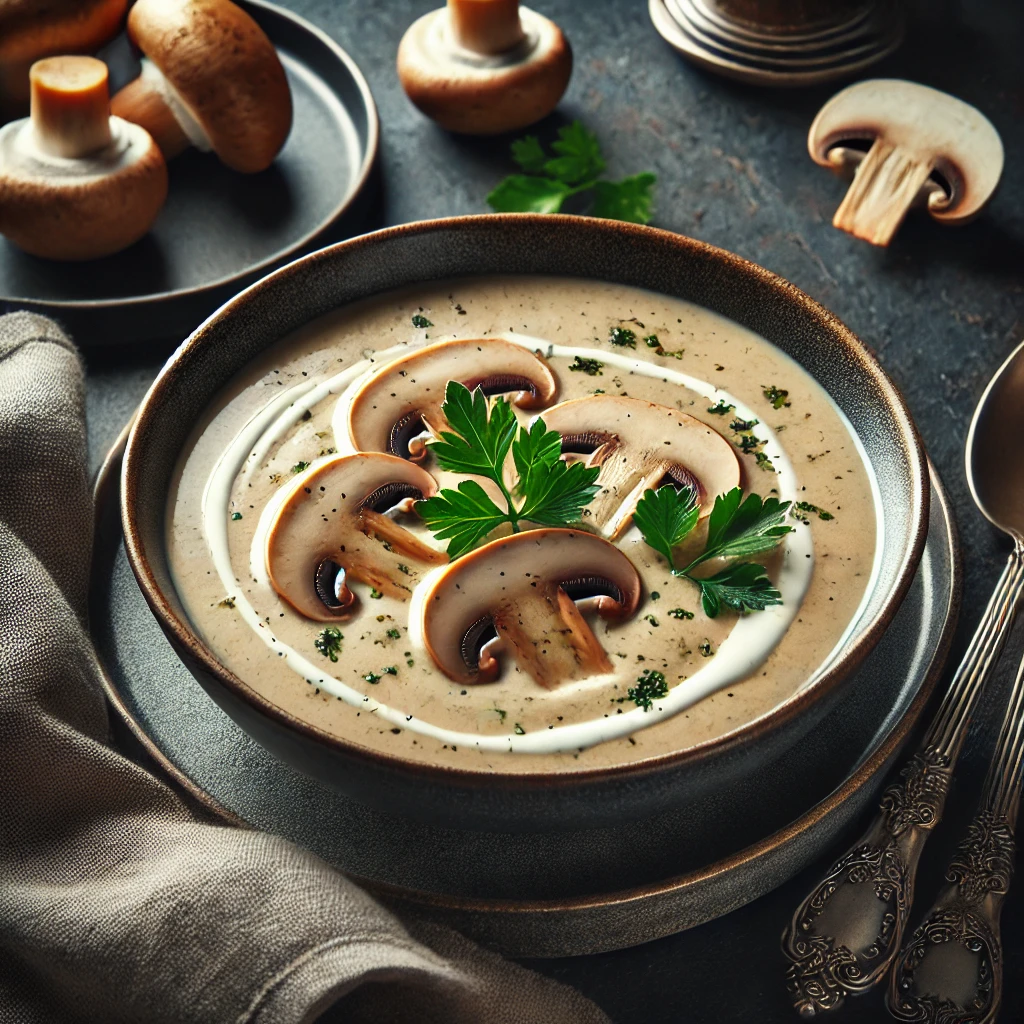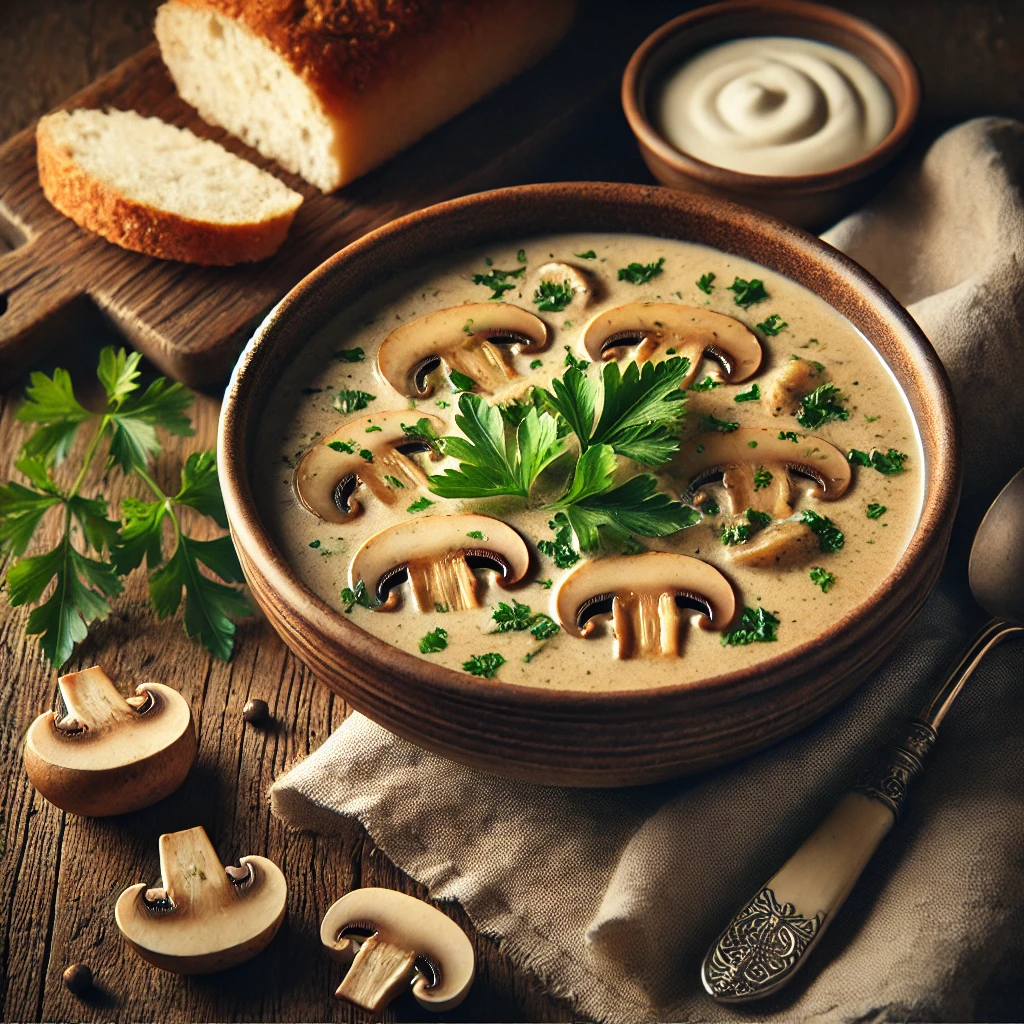Mushroom soup is a classic dish loved for its earthy, umami flavors and comforting warmth. However, the perfect mushroom soup often depends on achieving the right consistency. A thin soup can feel unsatisfying, while an overly thick one may lose the subtlety of its flavors. So, what are the best thickeners for mushroom soup? Let’s dive in.
Table of Contents
ToggleWhy Thickening is Important for Mushroom Soup
Thickening a mushroom soup enhances its texture, making it creamy and satisfying. A good thickener:
- Balances flavors: Thickening agents help the soup hold together, creating a harmonious blend of ingredients.
- Improves texture: It provides a rich, velvety feel that elevates the dish.
- Adds versatility: The right thickener can transform a light soup into a hearty meal.

Types of Thickeners for Mushroom Soup
Here are some popular thickening agents, from traditional options to innovative alternatives.
1. Flour-Based Roux
- A roux is a mixture of equal parts fat (such as butter) and flour cooked together.
- It is one of the most common ways to thicken soups and sauces.
- How to use:
- Melt butter in a pan.
- Add an equal amount of all-purpose flour and whisk until smooth.
- Cook the roux until it turns a light golden color, then stir it into the soup.
- Pros:
- Easy to make.
- Provides a classic creamy texture.
- Cons:
- Not gluten-free.
2. Cornstarch Slurry
- Cornstarch is a popular thickener for its neutral taste and quick thickening properties.
- How to use:
- Mix 1 tablespoon of cornstarch with 2 tablespoons of cold water.
- Slowly add the slurry to the simmering soup while stirring continuously.
- Pros:
- Gluten-free.
- Quick and effective.
- Cons:
- Overuse can make the soup gelatinous.
3. Potatoes
- Potatoes are a natural thickener and work beautifully in mushroom soup.
- How to use:
- Add peeled and cubed potatoes to the soup while it cooks.
- Blend the cooked potatoes with the soup for a smooth texture.
- Pros:
- Naturally gluten-free.
- Adds a hearty, creamy consistency.
- Cons:
- Alters the flavor slightly.
4. Cream or Milk
- Heavy cream or milk can add richness and a luxurious texture to mushroom soup.
- How to use:
- Stir in cream or milk during the final stages of cooking.
- Pros:
- Enhances the flavor with a silky finish.
- Cons:
- Not suitable for dairy-free diets.
5. Coconut Milk
- A dairy-free alternative to cream, coconut milk is ideal for vegan diets.
- How to use:
- Add full-fat coconut milk to the soup during the cooking process.
- Pros:
- Adds richness without dairy.
- Suitable for vegans and those with lactose intolerance.
- Cons:
- Imparts a slight coconut flavor.
6. Blending Mushrooms
- Blending a portion of the mushrooms is a natural way to thicken soup while retaining its flavor.
- How to use:
- Use an immersion blender to puree part of the cooked soup, leaving some chunks for texture.
- Pros:
- No additional ingredients required.
- Retains the earthy mushroom flavor.
- Cons:
- Requires a blender or food processor.
7. Bread Crumbs
- Bread crumbs absorb liquid and create a thicker texture.
- How to use:
- Add a handful of bread crumbs to the soup while simmering.
- Pros:
- Easy and inexpensive.
- Adds a rustic feel to the soup.
- Cons:
- Not gluten-free.
8. Arrowroot Powder
- Arrowroot is a gluten-free thickener similar to cornstarch but with a lighter texture.
- How to use:
- Mix 1 tablespoon of arrowroot powder with 2 tablespoons of cold water, then stir it into the hot soup.
- Pros:
- Gluten-free and easy to use.
- Doesn’t alter the flavor.
- Cons:
- Can thin out if the soup is reheated.
9. Cashew Cream
- Cashews can be soaked and blended into a creamy paste that thickens soups naturally.
- How to use:
- Blend soaked cashews with water to create a smooth cream.
- Stir it into the soup for a rich and creamy texture.
- Pros:
- Vegan and dairy-free.
- Adds a nutty richness.
- Cons:
- Requires a high-powered blender.
10. Egg Yolks
- Egg yolks add a silky thickness when tempered correctly.
- How to use:
- Whisk egg yolks with a small amount of the hot soup, then slowly stir the mixture back into the pot.
- Pros:
- Creates a velvety, smooth texture.
- Cons:
- Requires careful handling to avoid scrambling the eggs.
Tips for Perfectly Thickened Mushroom Soup
- Go Slow: Add thickeners gradually to avoid over-thickening.
- Taste and Adjust: Some thickeners may alter the flavor slightly, so taste frequently.
- Experiment: Mix and match thickeners for a unique texture and taste.
FAQs About Mushroom Soup Thickeners
1. Can I use almond flour as a thickener?
Yes, almond flour can thicken soup, but it may add a nutty flavor.
2. How do I make gluten-free mushroom soup?
Use cornstarch, arrowroot, or potatoes as thickeners instead of flour.
3. What is the healthiest thickener?
Blending mushrooms or using potatoes are natural, low-calorie options.
4. Can I thicken mushroom soup without adding calories?
Blending the soup or using arrowroot powder are great low-calorie methods.
5. Is heavy cream necessary for mushroom soup?
No, you can use alternatives like coconut milk, cashew cream, or blended vegetables.
6. Can yogurt be used as a thickener?
Yes, but ensure the soup is not too hot to prevent curdling.
7. What’s the best vegan thickener?
Cashew cream or blended mushrooms work well for vegan diets.
8. Can I thicken soup after it’s cooked?
Yes, cornstarch or arrowroot slurry can be added to already-cooked soup.
9. Does thickening change the soup’s flavor?
Some thickeners, like cream or bread crumbs, may enhance the flavor, while others, like cornstarch, remain neutral.
10. How do I fix a soup that’s too thick?
Add more broth, water, or milk to adjust the consistency.
By choosing the right thickener, you can create a perfectly creamy, delicious mushroom soup that suits your preferences and dietary needs. Whether you prefer a classic roux or a vegan-friendly cashew cream, the possibilities are endless. Happy cooking!

